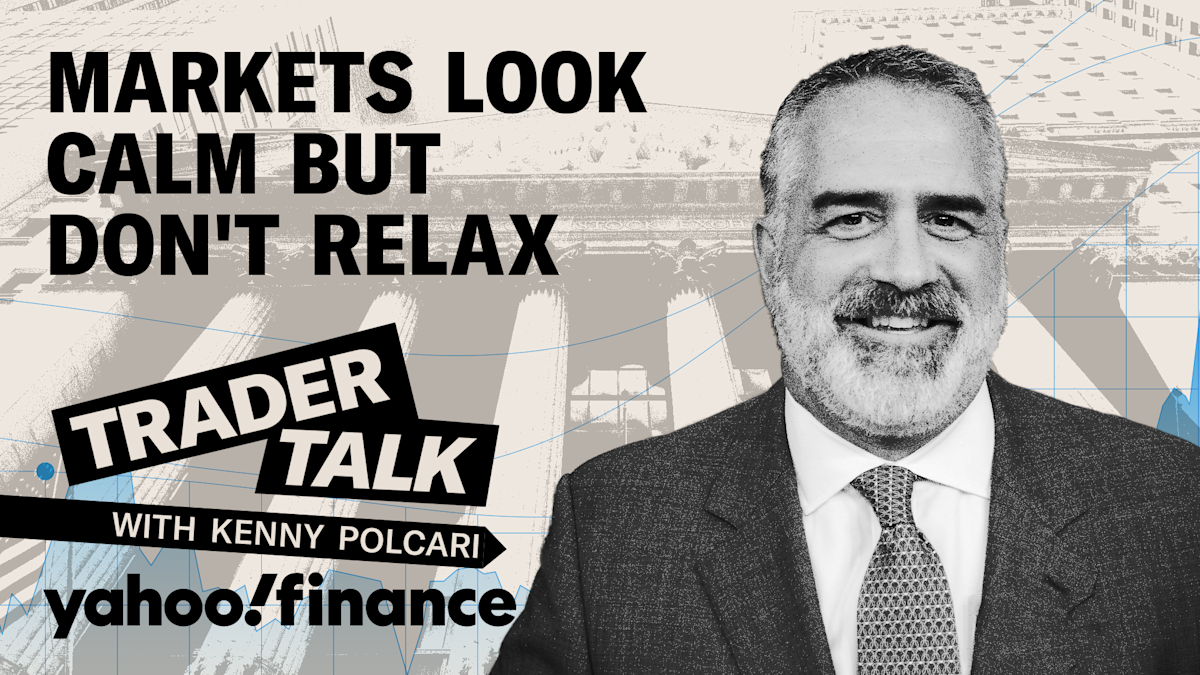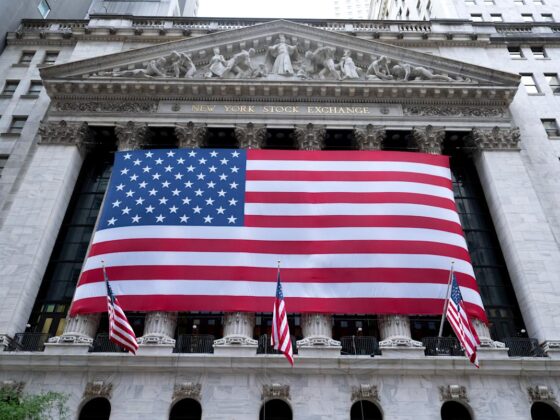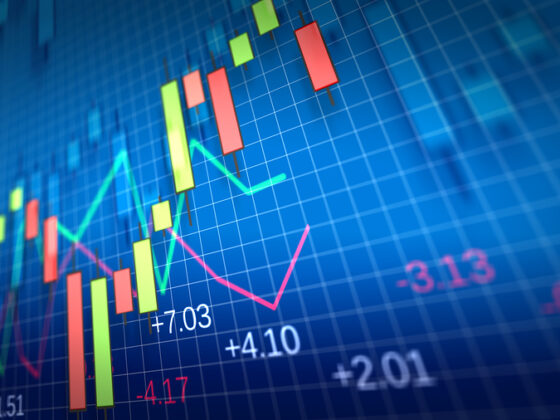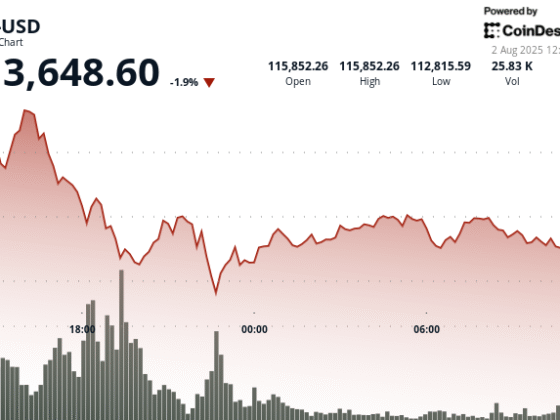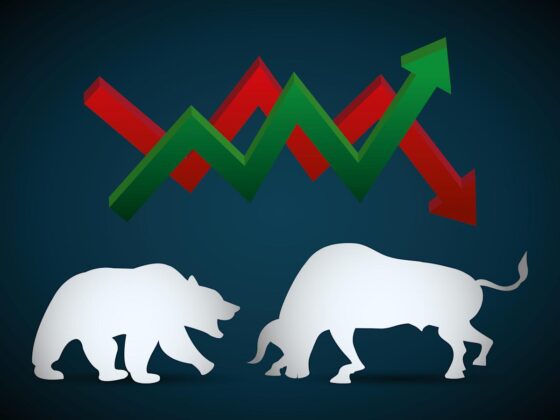0:05 spk_0
Welcome to Trader Talk, where we dish out the latest Wall Street buzz to keep your portfolio sizzling. I'm Kenny Polcari coming to you live from the Yahoo Finance headquarters in the heart of New York City, a global hub where deals are made, fortunes are built, and the next market move is always.Just around the corner. Coming up, I'll give you my big take on the Vicks and then sit down with RBC Capital Market's head of derivative strategy, Amy Wu Silverman, and I'll share with you my lemon ricotta fettucini recipe at the end. Now, let's jump into my big take.It always feels safest right before it gets dangerous. When you see the VIX at its lowest, when your when your account is up and the headlines are quiet, that's when most investors let their guard down. But the truth is, in today's market, peace is only an illusion. One unexpected Trump tweet can instantly send stocks into a tailspin, even if nothing really in the world has changed. Why?Because so much of the market is now run by computers that react in seconds to every headline. Trump doesn't need to pass a new law or sign an executive order. Sometimes he just tweets a threat or a wild prediction, and the algorithm starts selling or buying. Panic spreads in either way, either direction and volatility explodes, and investors who thought it was safe, scramble for the exits. Now, if you're new to the game, here's how to think about preparing.Don't get too comfortable when things are calm. Low volatility doesn't mean risk is gone. It just means it's hiding. When everyone's relaxed, that's actually the best time to set up some protection, whether that's buying a little insurance through options or holding a volatility ETF or simply keeping some cash ready on the sidelines. These things are cheapest when nobody thinks they need them, and they give you power when everyone else is rushing to react.Have a plan in mind for what you'll do if the market suddenly drops. The middle of a panic isn't the time to start making decisions. If you already know how you'll handle a sudden swing, you won't be stuck following the crowd. Instead, you'll be positioned to buy to buy.Great opportunities at a discount while others are forced to sell. Bottom line, volatility isn't gone, it's just waiting for the next surprise. Smart investors protect themselves before the chaos hits, not after. It's already too late. Don't wait for the panic. Be calm in the chaos.So now I'd like to introduce, uh, my guest today. Joining us is Amy Wu Silverman, managing director and head of derivative strategy at RBC Capital Markets. She's a leading voice in the world of options and volatility with a deep background in quantitative research and equity derivatives. Before joining RBC, Amy spent years on both the buy and sell side, building a reputation for translating complex market signals into sharp.Actionable insights. So ladies and gentlemen, please join me in welcoming Amy Wu Sullivan. Amy, it's a pleasure to have you and thank you for joining us on Trader Talk. Thank you for having me. So we're talking about volatility. There's certainly a lot of volatility in the markets these days, if not because of what's going on in this country politically, but certainly what's going on around the world and how that all plays into kind of the whole volatility.Mantra, right? So talk to us a little bit about what you think, here we are in mid-year, what you think about where volatility goes from here, what people should be aware of, you know, when it's at its lows, what should people really be concerned about because I always think when it's, you know, trudging around at the lows like this, everyone goes, oh, nothing's wrong, nothing wrong. That's exactly when you kind of have to prepare.
3:44 spk_1
Yeah, there's actually this old saying that strategists point to which is hedge when you can, not when you have to, right? And I think that piece of advice still holds true, you know, it was just Father's Day, so maybe I'll give you a bad ball joke instead of a bad dad joke. But, you know, we talk about the option Greeks a lot, so the delta, the Vega, the Theta, but, but you know, the most important one is actually.So it's just the sensitivity of implied volatility to Donald Trump's tweets right now because you're absolutely right. It's this uncertainty of what he could say, and the implications of that are vast.
4:26 spk_0
Well, and it's, but it's the answer yes, it is the uncertainty about what he could say, but it's kind of the uncertainty about what so many people can say on Twitter. They could post something that's that that's.Either not verified or it's erroneous. I mean, look, I remember and I tell this story all the time because I think it's, I I think it goes right to the point. You know, when, when I was still a floor broker on the floor of the New York Stock Exchange, uh, it was probably 2013-ish, 2014, and, um, Avon was going out of business, right? They were bankrupt.The stock was trading for pennies on the dollar, right?And it was well known that it was bankrupt. But then somebody put a tweet out, uh, that, that some equity, uh, uh, venture capital firm was buying Avon for $9 a share, made zero cents. But the fact is the tweet hit the market. Now this is also, you know, 2013, so it was, it was a dozen years ago, right?But the tweet hit the market, and the and the letters of the of the uh venture capital firm. It should have been PHG for instance, and it was PGH. So they just twisted the letters around. But if you looked at it quick, it, it made sense that, you know, you might have thought it was that. And suddenly Avon went from, you know, 30 cents up to $9 before you could even blink your eye.And then they came right out and denied denied the story cause it wasn't true. And then the stock went right back to 30 cents, which is clearly where it should have been. But that, that chaos that the tweets create, now that wasn't Donald Trump, that was somebody else that did it. But it's the fact that that tweets can create volatility up or down, no matter who says it.
6:00 spk_1
Absolutely. And, and you think about the way social media disperses things now, you know, so think back to the meme.That was a very options related phenomenon that hasn't really gone away, you know, it might not be on GameStop now or AMC, but if, if you were in a coma at the beginning of this year and you just woke up, you would have thought nothing's happened. But look, look at the whiplash we've had. And a lot of that has to do withYou know, when that news hits, you, you're right, you get those algorithms that immediately try to factor in that news, but then you get that human emotion too of the panic post liberation day, you know, this is the end of the world. We're really going to have 145% tariffs and let's degross immediately and then and then you get that that fear and that greed kind of combining on the way back and then.You kind of take that step back with hindsight and you say, oh, we didn't really move, did we? Yeah, we didn't
6:55 spk_0
and and and people get frustrated and rightly so, especially if you're a long-term investor, you get more frustrated. If you're a short-term day trader, you know, some people love that volatility because that's how they're making.In their money, but as a long-term investor, you can really get frustrated. And you know, as a market strategist and a uh and a wealth adviser now, I spent a lot of time after liberation Day when the market was crashing, trying to talk people off the edge. People that wanted to sell sell something like stop. You know, you really, you have to take a step back. And sometimes it's difficult, but, um, the, the, the chaos that it creates is really, I think, amazing. I do think though that people, especiallyInvestors might be getting a little bit more used to, you know, how that happens, right? It feels casino-ish, but it really isn't, but, you know, you can't help when they say it is or it feels that way.So talk to me about where we are in volatility now. We're mid-year. What do you think is happening for the rest of the year? And how do you think maybe investors, investors, not day traders, but investors should positionthemselves?
7:52 spk_1
Yeah, so one thing I'll say is one thing we look at really closely is not just how volatility is behaving in the near term, but how it's pricing 3 months out, 6 months out, 12 months out.So we call that the volatility term structure, but it's essentially a way of saying, what are your expectations in the future for how volatile this market will be? Right now, near term, it's actually pretty complacent, you know, we were talking before about the fact that it looks like Iran is trying to de-escalate the situation in the Middle East. So you know, we had that quick pop in the VIX, but now we've subsided.What is really interesting to me is when you look at that term structure 3 months out, 6 months out, 1 year out, there's a lot of
8:34 spk_0
nervousness. Right, so that's very interesting because I just want to make sure that the audience understands the short term is 3 months. Is that what the short term is? 3 months, right? So right now that's fairly complacent. People are not that worried, but if you look out 6 or 6 months or a year from now, they're much more worried.Means what are they doing for what's happening to the pricing of that volatility?
8:53 spk_1
Yeah, and look, every, every market, as you know, comes down to supply and demand. So when we say things look more uncertain, uncertain, essentially what we're saying is there's more demand for options to hedge. There's more demand for protection from investors who, who say, look, if there is a downturn 6 months from now or 1 year from now, I want to haveSomething in my portfolio that's going to kick in to protect me. That could be a recession. That could be the tariff impacts finally coming. That could be the soft data translating
9:23 spk_0
could bea could be arange of
9:25 spk_1
we, we don't know, but what we do know is even though we kind of had this whip saw and rally back in the market from April 2nd near term, it didn't ever change that longer.Term fear and I think that's interesting because it does speak to the fact that we still have a bunch of question marks that need to be resolved,
9:43 spk_0
right, because there are a bunch of so separate from the tariffs and separate for one moment for the geopolitical issues, we have our own issues here in the United States in terms of what the Fed's going to do or not do. Right now this week happens to be Fed week, right? So we're going to get their June rate decision.I, I don't think they're cutting rates, do you do? And I don't think they're cutting rates in July either, right? And then August we have the, we don't have a meeting because we have Jackson Hole, so the next meeting after that is September. There's some sense that maybe September they cut rates. Where do you stand on that?
10:12 spk_1
And so what I think is interesting is that term structure inflection, I think is pricing that that could happen, because the other thing that I think this gets lost a little, butThe demand for options doesn't always have to be to the downside. It could be to the upside. It doesn't really matter, right? It's just that if the demand is increasing, you're going to see that reflected in the volatility. So it could, you know, it could be saying the market's just going to have a big move. It doesn't say if that's a move to the downside or the upside, just that that magnitude is higher.
10:45 spk_0
So where do I, where do I or where does an investor see that information or they can't see it?
10:50 spk_1
Ah, I mean, I think they can see it on Yahoo Finance, so I, you know, you can essentially say.Where are the September S&P at the money options trading, like, let's make it really straightforward. And where are the December ones trading? Where are next year's trading, and you can kind of, if you plot that in a graph, um, you can kind of see those points start to go up. And and to be, to be fair, those points normally should go up because you probably know what you're going to do this weekend. You probably don't know what you're going to do a week. Maybe you do. Maybe you're a good planner, but I don't yet. So it is normal for what we call that term.Structure to be upward sloping, but our point is that it's way more upward sloping right now than it typically is, even adjusting for the fact that the future is more which
11:35 spk_0
then suggests that that the market is concerned there's going to be a move, something's gonna happen.
11:40 spk_1
Exactly.
11:41 spk_0
So let me ask you a question because, because a lot of times I talk about the Contra trades, right, which are, which are essentially helping you hedge. So whether it's you buy the SH, which is the S&P short, right? So if you, if you think the market's going.Down you would buy the SH, which gets you short, or the PSQ would get you short the NASDAQ, or the dog which gets you short the Dow, or the SPSX which is the S&P triple leverage short, which, which I always tell people that's not a long-term holding at all. And you have to be very careful because that can cut both ways, right? If it goes the opposite way, then if if the market goes up, it's going to cut 3 ways up to the upside. It's going to hurt 3 times as much. But those are other ways that people can play.Yeah and and and I guess in a simpler fashion, uh, than trying to come up with an options strategy, am I right?
12:28 spk_1
Yeah, but this is what I would say to me, you know, because what I do, my day job essentially is to to help like an asset manager or a hedge fund or a pension fund, say, OK, like, let's look at your portfolio, and if you really do think there's something to worry about, what's like the optimal way to to protect. But for for someone who has their own personal portfolio, right?The most important thing is what do you need the money for? Do you need it right now? You need it 30, if you need it 30 years from now, don't do anything, right? But if, if you need it 1 year from now because your kid's about to go to college and you need that liquidity, then that hedge is essentially a way of saying I'm going to lock in this amount that I need and I'm paying a little to do that, but the same way you have insurance, like that, that's what it is.
13:15 spk_0
All right. Hold on one second. We're going to take a break. We'll come right back.OK, so we're gonna pick up from where we left off about about planning, because it's really all about planning, right? To your point. I would say to a lot of people, if they need the money for their kids' education 6 months from now or a year from now, if you want to play it really safe, take it out of them.Market lead in cash. Just put it in treasuries because then you have no issue at all. You don't have to worry about what the market does up or down. Um, but to your point, if you want to, you know, if it's a year out, and you want to stay in the market but protect yourself, then you would do it that way,
13:51 spk_1
right? Yeah, and that's, that can be something, you know, as straightforward as just a put option on a broader market or it could be, you know, it depends what your positions are. And again, this is why I say.The day job is kind of to actually look through the portfolios and say, OK, you know, you own a lot of Apple. Apple's kind of been in the crosshairs, you know, for a variety of reasons that tweetter risk is really high. So we want to own some put options there on Apple or sell it,
14:18 spk_0
you know, because I, yeah, it's very funny you bring up Apple because I have one client that has an extremely concentrated position in Apple, uh.This guy's been buying it for 30 years. Any money he had, you know, it was when Apple was traded at $12 he just kept putting money in Apple. That was a good idea. It's a great idea. It's a great because it's a $20 million portfolio now, which is beautiful, but it's all Apple, right? So he's there's no diversification. He's completely, he's completely at risk, right now. Apple's under pressure to your point, and so, you know, this particular portfolios had a volatile time.But trying to hedge it, trying to, you know, uh, uh, create some income because you can certainly create income from a portfolio like thatas well.
14:58 spk_1
Absolutely. So, you know, one, another thing, it's funny because people use the word correlation to just say, you know, how much does this move relative to something else, but in our world, you can actually trade it. It's a product, right? You can trade the correlation itself. And one thing that we talk about.is what are the offsets. So, OK, you, you don't want to move your Apple. Maybe it's for tax reasons. Like, I don't know. There are a lot of reasons why you might not want to touch that. So essentially you want to find another asset that is uncorrelated, that is going to move in the opposite direction. Maybe that's another company. Maybe, maybe that is an option that's helping you again, reduce that, the fact that you're so concentrated, you have a correlation of one.We want to make that a little lower, right, to, to the tweet risk or whatever it is and you know that that's the type of thing that I think can be really interesting if you manage it the right way.
15:49 spk_0
So, so essentially what you're saying is I'm gonna buy something that's gonna, that's gonna react opposite to Apple. So if Apple loses 10%, hopefully the, the other investment that I'm now purchasing is going to rise 10%.So, so I haven't gone anywhere, but I haven't lost him. I haven't lost him any money. I'm, but I'm hedged, right? So one positions on and the other position's up. It washes each other. And
16:10 spk_1
you know, for a long time, I'm sure you know this, that was bonds and equities, right? For a long time, a lot of the portfolios that were constructed were, you know, 60% equities, 40% bonds, because people relying on that correlation to help them out. One's going one way, one's going the other.And the problem is, uh, that has broken down. There are all these relationships in the market that we counted on both in options and in bonds and in stocks where we can't count on that anymore. And so we're trying to figure out what those new relationships are because they're really important. Yeah,
16:43 spk_0
they'revery important. So listen, let me ask you a question. Based on your world and what you know in this conversation we're having, what's your sense?Uh, and, and I'm not holding you to it. I'm just kind of get a sense of what's your sense of where the market's gonna be the end of the year or a year from now?
17:00 spk_1
Yeah, here's what I would say. I, I am not officially the chief equity strategist, so I'm not speaking and, you know, on their behalf, but what I would say is when you look atWhere we start at the beginning of the year, let's pretend tariffs didn't like, let's pretend the tariff thing never happened. Pretend there was no geopolitical risk, just purely on the economics of the beginning of this year. We already worried about a decent amount of things. So we're already a little bit worried about growth. We're already worried that kind of this cases shaped recovery, so meaning the high end consumer.was really bringing this market along um was also starting to wane, and this is prior to throwing in the tariff risks, throwing in the geopolitical risks. So, you know, our chief strategist has this great phrase which I love, which is called aggressively neutral, but it's just this idea that probably fromHere, just for evaluation reasons, we were at a point where perhaps this year the upside was limited. And so we, we started this year with an outlook that said, look, if you want to be in an environment where you're collecting more yield, use volatility to help you. So that could be yield enhancing strategies or using some of that yield to maybe fund some downside protection.But everything we talked about in our year ahead outlook for the end of this year was managing for scenario at the end of this year, you know, maybe the market is up a handful of percent, but not a 20%,
18:26 spk_0
and so, and so that's the exact point. Look, we had a couple of years where the market was up plus 20%. Well that was really out of the norm. It was way outside of the bell curve, right? Returning to an 8 to 10% return on stocks and if you're adding divvies, maybe you're 12%.Which is historically normal, which I think is, which is great. And so we've been preparing, you know, at Slatestone, I've been, we've been preparing investors to consider the fact that we're going to go back to a 1010 or 12% return, which by the way, works, right? This, this, this 20% or 25% return year in and year out, not happening.And so people need to understand that, but you know, it's funny because they, after they see the last two years what they've returned, and then going back to 10%, it feels like it's a failure. It's not a failure at all. A failure might be if we're down 30%. That's the failure, right?
19:14 spk_1
And, and I also don't think that's going to happen either, you know, I don't think it's going to be past this growth scare into this. I, I don't think we're there, you know, it's again, it's.Fortunately, you know, it's not going to be as sexy as the plus 20% market, but it won't be a 2008 either. Yeah, no,
19:29 spk_0
absolutely not a 2008. I don't think that's going to happen, but to your point, I don't think it's going to be another multiple 25%, you know what I mean? I just don't see it. Um, anyway, listen, I'd like to revisit this, you know, maybe in another six months and come back and see where this conversation went because ITo think that that, you know, there's something coming. I think I'm, I tend to be more optimistic, so I think the next move is gonna be higher, not significantly, but I, I don't think we're going to be down to 4800 by the end of the year at all, right? I think we're gonna be somewhere between 6000 and 6400, I think, by the end of the year.
20:01 spk_1
You'regonna wake up from that coma and not think anythinghappened,
20:04 spk_0
but you know, we'll, we'll revisit that in 5 or 6 months. I'd love to have you back.In the meantime, you know how I end every podcast with a recipe, and today, uh, I thought I'd featured those and I made it yesterday for Father's Day. It was delicious. This lemon ricotta pasta, right? It's a dish that really reflects, uh, Southern Italian cooking. It's fresh, it's seasonal. It's just simple and beautiful. Its roots can be traced back to Campania and Sicily, where lemons grow in abundance along with sun-drenched coastlines in the ricotta, is a staple in both sweet.And savory dishes, right? Uh, ricotta itself dates all the way back to Roman times, and its name actually means recooked, referring to how it's made from the whey left over in the cheese production. In southern Italy, fresh ricotta is prized for its creamy, slightly sweet flavor and is often paired with citrus to highlight the freshness. The idea of combining lemon and ricotta with pasta emerged as a way to create a luxurious feeling dish without meat.Especially uh during lean times or even during Lent when a lot of Italians don't eat meat, right? Lemon adds brightness, cutting through the richness of the cheese, while the pasta water, which I call tears of the gods, uh, helps to emulsify it all into a light creamy sauce. It's a warm weather favorite today for good reason. It's quick, it's elegant, and it's full of Mediterranean sunshine in every bite. You can scan the QR code that's on the screen to get the full.and you can thank me later for that. Look, that's a wrap for today's trader talk, but the conversation will keep going. Subscribe on Apple Podcasts, Spotify, Amazon Music, or wherever you get your podcast. You've got a question or a topic you'd like me to cover? Email us at tradedertalk@yahoo Inc.com because I'm always listening. Until next time, stay sharp, stay calm, stay disciplined and stay in touch. Take good care.
21:58 spk_2
This content was not intended to be financial advice and should not be used as a substitute for professional financial services.

